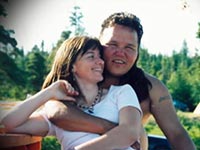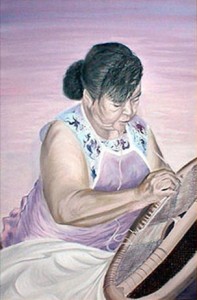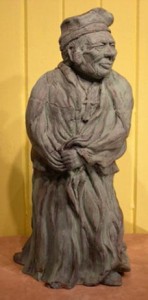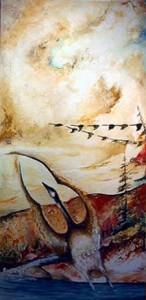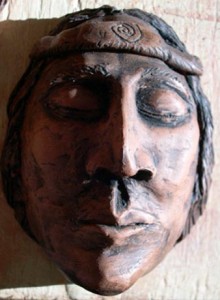Anisheniu Jean-Pierre Fontaine, born in Uashat on the North Shore, is a painter and sculptor, as well as a singer-songwriter-composer. In his performing career he developed a concern for direct communication with spectators, which carries over intact in his visual artworks. We are struck by the lightning clarity of his visions, hitting us with an urgency to be recognised for the insight they bring. Each of this artist’s works becomes part of the most authentic expressions of the soul of the First Nations.
Isabelle Courtois, born in France, found the space of freedom and truth she needed in First Nations art. Attentive to the fragile signs which express the souls of the living, she devotes all her creativity to convey the authentic emotion coming out of the encounter between her universe and that of the Innus.
Ashukan is a link between two creators, a bridge between two cultures coming together around a multidisciplinary body of work combining song, visual arts and traditional crafts to provide a sensitive and respectful portrait of contemporary First Nations.
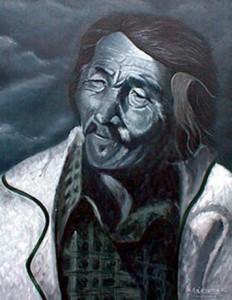
Innu
c. 2003
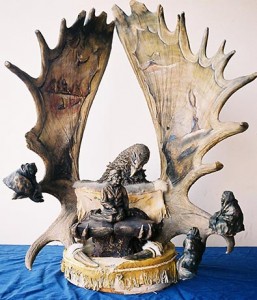
Teachings of the elder woman
Ashukan, 2005
Artists’ book
Sculpture, painted elk antlers, terra cotta, caribou hide, fur, feathers, leather, beads and wood
“…our book contains no writing, but on the pages there is a scene of an Innu grandmother’s teachings to her grandchildren sitting around her and listening attentively to her.”
“The eagle, the highest-flying bird, represents the link between the Creator and man. It links heaven and earth and brings us subtle and essential knowledge. This is why it brings us the Great Book, symbol of knowledge, of the memory of Peoples, in its talons.
When we begin to listen to Nature and animals, we can hear their wise words. This is what the pictograms painted within Eagle’s wings mean. In Amerindian traditions, knowledge is passed on through speech and, there are very few written traces in the literal sense, except for pictograms. For this reason, our book contains no writing, but its pages set forth a scene of an Innu grandmother’s teachings to her grandchildren sitting around her and listening attentively to her”.
This scene recalls the way of life of nomadic Innu: while the men were away hunting, fishing and trapping on their hunting grounds, the women tended to the campsite’s well-being and brought up children by telling them legends.
The grandmother, nukum in the Innu language, is the living symbol of knowledge acquired through life experience.
The characters are created from clay, a symbol of the Earth element, in perfect symbiosis with the Eagle who hails from the sphere of rarefied air.”
Isabelle Courtois and Jean-Pierre Fontaine
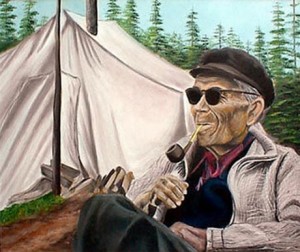
Innu devant sa tente (Innu in front of his tent)
Ashukan, c. 2003

An Innu chess game
Ashukan, 2003
Chess set
Ivory, antler tines, smoked hide, thread, beads, acrylic and wood, 15 x 15 x 10 in.
Caribou, with a very wide range in the north, is the Innus’ sacred animal. Caribou is the basis of their forest subsistence: their diet, their garments and moccasins as well as the crafting of traditional tools all depend on bountiful hunts.
Each of the pieces in the chess set was carefully carved from caribou bones. The base of each piece is covered with hide cleaned with tools carved from the animal’s tibia, and then tanned and smoked according to the ancestral method.
The struggle waged on the chessboard symbolises the historical encounter between traditional Innu culture and the religion brought by missionaries when Europeans arrived on this continent.
It is important to point out that this struggle actually took place in the past because the Church categorically rejected the beliefs and ritual objects that the Innu had relied on since time immemorial.
These symbols are found on the chess pieces and on their base in caribou hide in the form of primitive paintings.
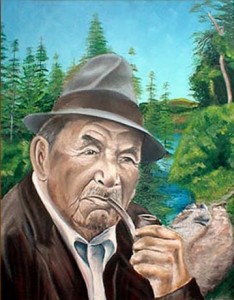
Innu devant une rivière (Innu in front of a river)
Ashukan, c. 2003
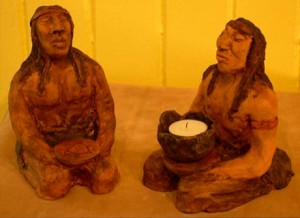
Chandeliers (Candle holders)
Aînée fabriquant une raquette (Innu woman making a snowshoe)
Innue en costume (Innu in a traditional costume)
Oie prenant son envol (Goose taking flight)
Tête (Head)
Ashukan, c. 2003
